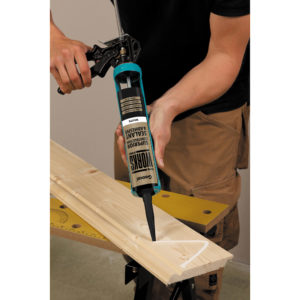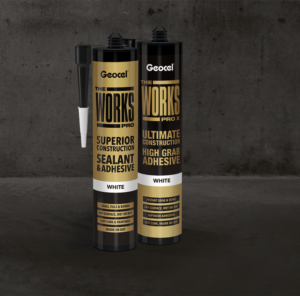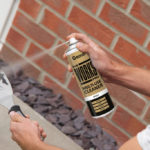Andy Cummins, Senior Product Manager at Geocel, identifies the key areas that need to be considered when applying a sealant or adhesive. Only by making an informed decision, can you ensure an effective installation that does not degrade rapidly over time.
For housebuilders, build quality and attention to detail is a contentious issue. Good quality, reliable sealants and adhesives should play their part. While the market is flooded with options to choose from, it is important for housebuilders to ensure the right sealant or adhesive product is selected for a job, so it is fit for purpose. Here are the three main factors to consider:
- In what environment are you applying the product?
- What is the substrate material due to be sealed or bonded?
- Which sealant chemistry would work best?
 Environment
Environment
When selecting and applying a sealant or adhesive, it is important to think about the conditions that the seal will be exposed to, as this will impact how well it can perform.
Products designed for outdoor conditions should be weather and UV resistant and need to withstand a higher temperature range. Dependant on required use this could be a temperature requirement of up to 300ºC in the case of flue sealant silicones. Failing to use a product with these specifications on the exterior of a building could result in the product breaking and lead to the seal failing.
Similarly, sealants used for interior settings have their own traits. For example, products designed for bathroom settings in particular, will usually feature excellent adhesion to non-porous surfaces and contain fungicide to resist bacteria growth, such as MRSA, E.Coli and Salmonella. Using a poor quality sealant or adhesive in this case could risk exposing areas of the bathroom to moisture, which in turn could lead to serious water damage for the future homeowner as well as the possibility of unsightly mould and mildew growth.
Substrate material
While many sealants and adhesives are versatile and designed for use in multiple applications, some are developed or recommended for use with specific materials.
When working with windows and doors made from aluminium, PVCu or wood a neutral silicone, suitable for weather sealing, is the correct choice as it will have a good adhesion to the non-porous surfaces such as the brick or stonework found around a window or doorframe. These silicones are highly flexible, offer a 20-30-minute working time and fast cure time.
 On the other hand, glazing silicones are designed to maintain a very clear finish against a glass substrate. Of the options available when glazing, acetoxy glazing sealants are great for single pane glass and non-porous surfaces; whereas neutral glazing silicones should be used for laminated glass and when in contact with insulated glass (IG) units and other non-porous surfaces.
On the other hand, glazing silicones are designed to maintain a very clear finish against a glass substrate. Of the options available when glazing, acetoxy glazing sealants are great for single pane glass and non-porous surfaces; whereas neutral glazing silicones should be used for laminated glass and when in contact with insulated glass (IG) units and other non-porous surfaces.
Sealant Chemistry
After considering the environment and material, it is then crucial to select the most appropriate sealant or adhesive in terms of formula, as this will determine the quality of the installation. There are numerous sealant and adhesive products available, but the three most common are silicone, acrylic and MS Polymer – all have specialist and multi-use applications to offer.
Silicones
Silicone sealants are a popular choice as they are versatile and adhere well to a wide range of construction substrates. Available in a variety of colours, silicones have excellent UV and colour stability and offer extreme temperature resistance. They also provide excellent elasticity and durability.
Silicones are renowned for their elastic and water-resistant properties and as such are well suited to expansion and connection joints in sanitary areas, floors, walls and glazing applications. Furthermore, silicones have an established heritage across all areas of construction. For example, Dowsil, a leading brand in silicone sealants, has been used to seal glazing on many of the skyscrapers around the world– giving users the added reassurance that if they can be used on iconic buildings, they can be trusted with the day to day.
Acrylics
Best used in in applications where there is low movement, and little or no contact with water, Acrylics unfortunately do not offer the same flexibility or weather resistance as silicones. However, an acrylic is great for caulking and filling gaps and also works well on plastered walls, masonry and wood – particularly as it can be overpainted. Products such as Geocel’s Painters Mate Flexible Filler are ideal for hairline cracks as no sanding is required and it can be overpainted in just one hour. They are also easy to gun and tool – ideal for the untrained user.
MS Polymers
Lastly, MS Polymers are available – and are considered to be the ‘newbie’ to the trade market. Often performing as an adhesive and a sealant, they offer excellent compatibility and adhesive properties on brick, metal, glass, plastic, tile, wood or stone surfaces, and many more. Furthermore, its non-staining properties make it ideal for projects such as sealing marble or granite kitchen work tops. This product can also be applied directly onto wet or dry surfaces and will bond and cure underwater. In addition, once applied, MS Polymers will not attack synthetic materials, unlike solvent adhesives.
MS Polymer products feature many of the most desirable attributes of traditional sealants, offering the paintability associated with sealants made from organic materials (such as polysulphides, polyurethanes and oil based mastics), along with the flexibility and UV stability of silicones. Combined sealants and adhesives make great multi-use products, so an ideal option for housebuilders needing to address any snagging issues on site. MS Polymers such as THE WORKS PRO Superior Construction Sealant & Adhesive from Geocel, are incredibly effective all-rounders, as they can seal, fill and bond almost any surface, wet or dry, inside or out.
When it comes to choosing a sealant, a product’s suitability and reliability are key, with callbacks not just a hassle but a waste of precious time. While repairing mistakes can be done, it can severely impact a housebuilder’s reputation as well. The type of sealant specified for a project might seem such a minute detail considering of the wider product specification from a development, but it is worthwhile taking the time to select the right sealant for the job, ensuring a lasting finish.



